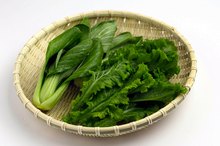What does fact checked mean?
At Healthfully, we strive to deliver objective content that is accurate and up-to-date. Our team periodically reviews articles in order to ensure content quality. The sources cited below consist of evidence from peer-reviewed journals, prominent medical organizations, academic associations, and government data.
- MayoClinic.com; Whole Grains: Hearty Options for a Healthy Diet; July 21, 2009
- Linus Pauling Institute Micronutrient Information Center; Glycemic Index and Glycemic Load; Jane Higdon; December 2005
The information contained on this site is for informational purposes only, and should not be used as a substitute for the advice of a professional health care provider. Please check with the appropriate physician regarding health questions and concerns. Although we strive to deliver accurate and up-to-date information, no guarantee to that effect is made.
The Health Benefits of Kasha
Kasha, or buckwheat groats, is a whole grain, which you can eat as a side dish, in recipes or as a breakfast cereal. It is a nutrient-dense food, and it may provide some health benefits. Consume kasha in moderation along with other nutritious foods, and talk to a nutritionist if you are unsure about how to include kasha in your diet.
Healthy Blood Pressure
Each cup of cooked kasha supplies 148 mg potassium and only 7 mg sodium. A high-sodium, low-potassium diet can lead to high blood pressure, which increases your risk for heart disease, stroke and kidney disease. Healthy adults should have at least 4,700 mg potassium and no more than 2,300 mg sodium per day, according to the 2010 Dietary Guidelines from the U.S. Department of Health and Human Services 1. Many dietary and other factors affect your blood pressure, and your doctor can advise you about keeping your blood pressure within a healthy range.
- Each cup of cooked kasha supplies 148 mg potassium and only 7 mg sodium.
- Many dietary and other factors affect your blood pressure, and your doctor can advise you about keeping your blood pressure within a healthy range.
Whole Grain
Wheat Chex Cereal Nutrition Information
Learn More
If you have gluten intolerance or wheat allergies, you need to avoid wheat products. A benefit of kasha is that it is a wheat-free source of whole grains. Even if you are able to eat wheat, kasha can help you increase your intake of whole grains, which may lower your risk for heart disease. The average American gets only 15 percent of the recommended amount of whole grains, according to the 2010 Dietary Guidelines from the U.S. Department of Health and Human Services 1.
- If you have gluten intolerance or wheat allergies, you need to avoid wheat products.
- Even if you are able to eat wheat, kasha can help you increase your intake of whole grains, which may lower your risk for heart disease.
Low-Glycemic
Kasha, or cooked buckwheat, has a low glycemic index, which means it does not have the potential to spike your blood sugar levels as severely as high-glycemic foods 3. Whole grains and less processed carbohydrates tend to be low-glycemic, while higher-glycemic carbohydrates tend to be refined starches such as refined pasta, baked potatoes or white bread or rice 3. A low-glycemic diet can lower your risk for developing insulin resistance and type 2 diabetes, and it may help you control your weight, according to the Linus Pauling Institute 3.
Beneficial Nutrients
Kidney Stones & Popcorn
Learn More
Each cup of cooked kasha, or buckwheat groats, provides 4.5 g dietary fiber, or 18 percent of the daily value. Dietary fiber can help lower levels of LDL, or "bad," cholesterol in your blood and reduces your risk for constipation. Most Americans get less than half of the recommended amount of fiber, according to the 2010 Dietary Guidelines from the U.S. Department of Health and Human Services 1. Kasha provides just under 10 percent of the daily value for choline, niacin and iron.
- Each cup of cooked kasha, or buckwheat groats, provides 4.5 g dietary fiber, or 18 percent of the daily value.
Related Articles
References
- U.S. Department of Health and Human Services; Dietary Guidelines for Americans, 2010; January 2010
- MayoClinic.com; Whole Grains: Hearty Options for a Healthy Diet; July 21, 2009
- Glycemic Index
- Linus Pauling Institute Micronutrient Information Center; Glycemic Index and Glycemic Load; Jane Higdon; December 2005
Writer Bio
Natalie Stein specializes in weight loss and sports nutrition. She is based in Los Angeles and is an assistant professor with the Program for Public Health at Michigan State University. Stein holds a master of science degree in nutrition and a master of public health degree from Michigan State University.









